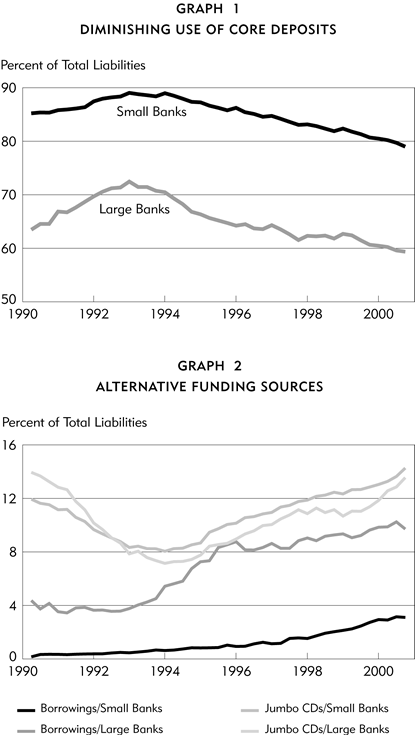In the last decade, banks have been forced to replace deposits that are insured by the federal government with uninsured or jumbo deposits. In fact, these deposits have risen by more than 160 percent over the last six years.
Regulators have expressed concern about banks' shift away from insured deposits because it can raise costs and leave banks vulnerable to less stable funding. But the increased use of uninsured deposits may not be all bad news. In particular, the prices that banks pay on uninsured deposits and the changes in the amount of uninsured deposits banks hold could help regulators assess the financial condition of the bank. To be sure, additional data on prices and research into jumbo CD flows and prices are needed before regulators could reasonably rely on these types of market data, and we make recommendations in that vein. In addition, policymakers need to take additional steps to put the holders of uninsured creditors at the largest banks at clearer risk of loss.
Shifts in funding sources to uninsured deposits
The federal government insures the deposits in bank accounts up to $100,000, thereby protecting the holder of the account from loss upon the failure of their bank. The absolute amount of insured deposits at banks has been rising steadily over the years—increasing roughly 20 percent in the last six years alone. However, the share of bank funding generated by these deposits has been falling since the early 1990s across the industry. When analyzing bank funding, we rely on information from the regulatory reports that banks file each quarter in which deposits are divided into five categories: transaction accounts (for example, checking accounts), savings accounts, money market deposit accounts, small time deposits (certificates of deposits with a face value less than $100,000) and large time deposits.* The first four categories represent the primary funding sources of most banks and are collectively known as core deposits. Although it is possible for some of the funds held in these core deposits to be uninsured (an example would be a checking account with a balance greater than $100,000), the vast majority will be covered by the insurance fund. As such, core deposits can serve as a proxy for the amount of insured deposits in the banking system.
Graph 1 illustrates the relative decline in core deposits for large banks, those with over $1 billion in assets, and small banks with under $1 billion in assets (unless noted, all financial ratios are the average of all individual bank ratios). We segment the data because large banks make much less use of core deposits than do small banks. Both groups, however, have had a similar percentage point decrease (about 12 percentage points) in their relative core deposit funding. Analysts attribute this decline to demographic shifts to age cohorts that are less likely to hold insured deposits and a simultaneous change in the preferences of all households.

Graph 2 details two alternative funding sources, borrowings and jumbo deposits, which large and small banks have used extensively to replace insured deposits. Borrowings consist primarily of advances that member banks receive from the Federal Home Loan Bank system (FHLB). The growth in borrowings in recent years has outpaced that of uninsured deposits at both large and small banks. (See "Financial modernization, the FHLB and agricultural banks" in the October 2000 fedgazette for a discussion on the potential for future growth of FHLB funding.) However, uninsured deposits still account for a higher percentage of bank funding, especially among the nation's smaller banks. Moreover, the increase in unsubsidized jumbo deposits is just as large for banks that use subsidized FHLB advances as it is for banks that do not (see table below).
| Does More FHLB Borrowing Preclude The Need For A Long-Term Investment? |
| Some might question the need to invest in understanding jumbo deposits, given the increase in the use of Federal Home Loan Bank system (FHLB) funding by banks. After all, jumbo deposits can only play a role in signaling risk taking if banks continue to use them. Analysts and bankers have pointed to FHLB funding, not jumbo CDs, as the preferred option for replacing core deposits. In particular, the subsidized status of FHLB funds should make them more attractive than market-priced jumbo deposits. But this expectation depends on the FHLB consistently giving the best deal to its members. This may not be the case. We find that banks borrowing from the FHLB, banks that are members of the FHLB but do not currently borrow from the FHLB and banks that are not members of the FHLB have had an equal increase in their use of jumbo deposits. Although this trend could reflect the fact that most banks find themselves in good financial shape and do not seek out FHLB funding, it suggests the need to scrutinize claims made about FHLB funding superiority. |
Regulatory concerns
Bank regulators have expressed several concerns about the increased use of jumbo deposits and the decline of core deposits. Banks pay more to raise jumbo deposits, so increased use means reduced profitability. Regulators worry that banks may take on more risk to regain profits. In addition, because the holders of jumbo deposits are more sensitive to the returns on alternative investments and the financial condition of the bank, an institution that relies on jumbo deposits for growth could find itself without a source of funds in the future. Regulators have particularly criticized banks that they believe do not have adequate managerial resources to manage more volatile uninsured deposits.
Because policymakers will hold regulators accountable for bank failures, regulators naturally take steps that they think make bank closings less likely, such as criticizing the rising use of jumbo deposits. Yet, the sensitivity of jumbo deposit holders also has the potential to serve regulators' goals by providing market assessments of the risk taking of banks.
Market discipline?
There is a growing consensus that bank regulators should make greater use of the market's assessment of bank risk taking. Increased use of uninsured deposits by banks could facilitate regulators' exploitation of market data. In particular, a holder of uninsured bank liabilities who will lose money when a bank fails has an incentive to monitor a bank's financial condition. When the bank assumes more risk, the uninsured depositors will have to charge a higher rate to receive compensation for the increased risk they assume. The higher market prices, therefore, send a signal of greater bank risk taking to regulators who can then act accordingly by, for example, giving such banks more scrutiny. Of course, regulators cannot rely on depositors insured by the federal government to provide similar signals.
Although regulators and analysts are in general agreement on the need to look to market signals when regulating banks, there are several concerns about looking to jumbo CDs for such information, including the ability of jumbo depositors to assess risk taking, the incentive jumbo depositors have to assess risk and the use of uninsured deposits by banks in trouble.
Can uninsured depositors assess risk?
Banks can assume additional risk in ways that might not be clear to the public, such as making a loan to a firm that appears strong but is near insolvency. As a result, some observers have expressed concern that uninsured depositors may not fully incorporate the increased riskiness of the bank into pricing. This worry is not consistent with a very large body of research over the last decade indicating that holders of uninsured deposits do charge higher prices to riskier banks. Recent work confirms this finding even at relatively small banks (for example, banks with as little as $100 million in assets).
To provide additional, more current evidence on the matter, we examine data from banks' financial reports to determine if banks with high-risk characteristics pay higher rates on uninsured deposits. Bank financial reports do not state these prices directly, so we must impute them. We find a strong relationship between jumbo deposit prices and bank risking taking for the banks that paid the highest and lowest rates on their jumbo deposits. The table above shows the average of three common measures of bank risk (capital levels, loan losses as a percent of average loans and noncurrent loans as a percent of total loans) for banks whose imputed jumbo deposit rates were in the bottom 5 percent of all commercial banks (the safest banks) and those in the top 5 percent (the riskiest banks) in 1999. As expected, the banks that paid the lowest rates had higher average capital levels and stronger asset quality—all characteristics consistent with low risk taking.
Do uninsured deposits have the incentive to assess risk?
We have assumed so far that uninsured depositors believe they are at risk of loss given their lack of explicit government protection. This assumption is sound for the vast majority of banks even though the federal government bailed out uninsured depositors during the last banking crisis. Legal changes made in 1991 have firmly put the uninsured at small banks at risk of loss (see graph 3 for the percent of cases where uninsured depositors lost money).

We are less sure about the government's commitment to letting uninsured depositors at the largest banks bear losses. Federal policymakers may want to bail out the largest, so-called too-big-to-fail banks in order to prevent failures of related firms or the seizing up of financial markets. To put the very largest and smallest banks on an even playing field, the Federal Reserve Bank of Minneapolis and others have suggested reforms that would require all uninsured bank creditors to bear some risk of loss (see "Fixing FDICIA: A Plan to Address the Too-Big-To-Fail Problem," 1997 Annual Report essay).
| Relationship Between Risk Levels and Uninsured Deposit Pricing |
|||
|---|---|---|---|
|
Capital | Loan Losses | Noncurrent Loans |
| Lowest Jumbo Rates | 14.9% |
0.23% |
0.74% |
| Highest Jumbo Rates | 11.3% |
0.45% |
1.57% |
| Source: Consolidated Reports of Condition and Income | |||
Uninsured deposit use by banks in trouble
The riskiness of banks can show up both in prices and in the quantity of uninsured deposits that the bank holds. For example, uninsured depositors may decide to pull their funds from a bank if the risk taking of the bank increases rather than demand a higher rate. More importantly, the bank can systematically try to raise more insured funds from less-sensitive depositors as its uninsured deposit rates rise. The available research on this question confirms that as banks increase their risk, they increase their use of insured deposits. Prices of these insured deposits would not provide good signals on bank risk taking.
Along those lines, an economist with the Boston Fed examined failing banks in New England. He found that the failing banks experienced a 70 percent decline in their uninsured deposits in their final two years of operation. These banks were able to raise insured deposits to replace the fall in uninsured deposits.
To further investigate this potential, we examined the uninsured deposit flows at banks that moved from favorable regulatory assessments of their financial condition to poor regulatory assessments during the last six years. Although these regulatory assessments are not made public, they are at least partly based on qualities of the bank that are observable to all. We find that in the eight quarters leading to the rating change these banks increased their use of jumbo CDs—consistent with the fact that banks in general were making greater use of this type of funding during this period. In the eight quarters following the change to a poor regulatory assessment, however, these banks steadily decreased their reliance on jumbo deposits—while the rest of the industry continued their increase.
These patterns suggest that regulators could not rely solely on jumbo CD prices but would also need to look at the flows of these funds. However, more rigorous analysis of these flows is needed before regulators could feel comfortable taking action based on such data. We do not know, for example, if a reduction in jumbo CD use is a systematically good predictor of future risk taking.
Recommendations
There are good reasons for regulators to look at the prices paid on jumbo deposits. Unfortunately, the regulatory reports do not directly state these prices. We recommend that such data be collected in a form that allows regulators to use these signals to help assess bank risk taking. Price data by itself will probably be inadequate as banks can shift from uninsured to insured deposits as their financial condition falters. We recommend that regulators and researchers monitor and analyze uninsured deposit flows to better understand how they relate to bank risk taking. We also recommend that policymakers adopt reform plans that would more clearly put uninsured depositors at risk of loss at the largest banking organizations.
* The regulatory reports are officially titled the Consolidated Reports of Condition and Income but are better known as the Call Report. Data from these reports can be found at on the Chicago Fed's Web site.






